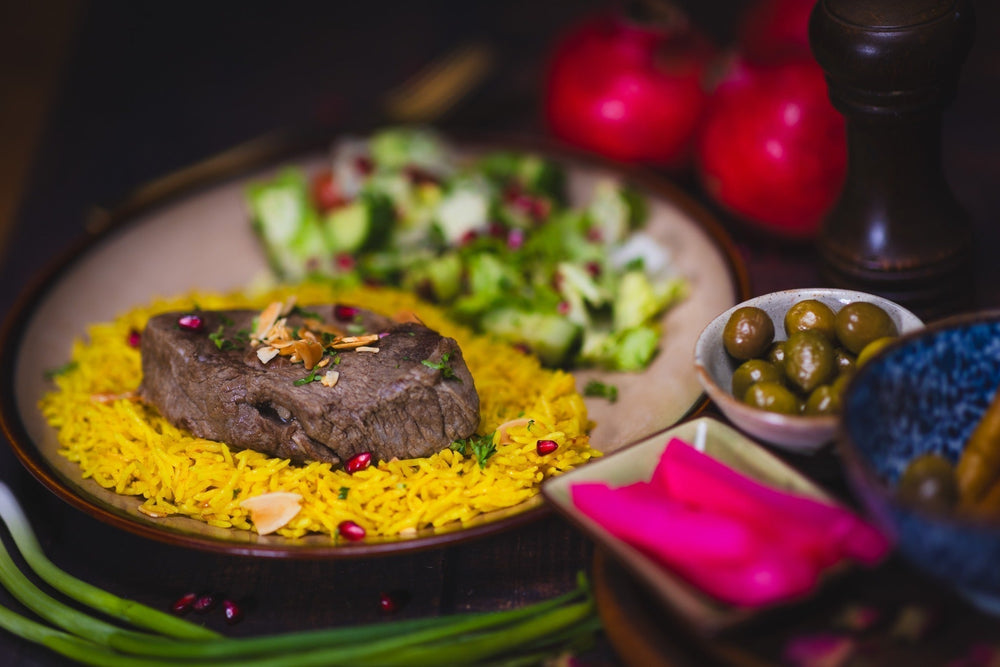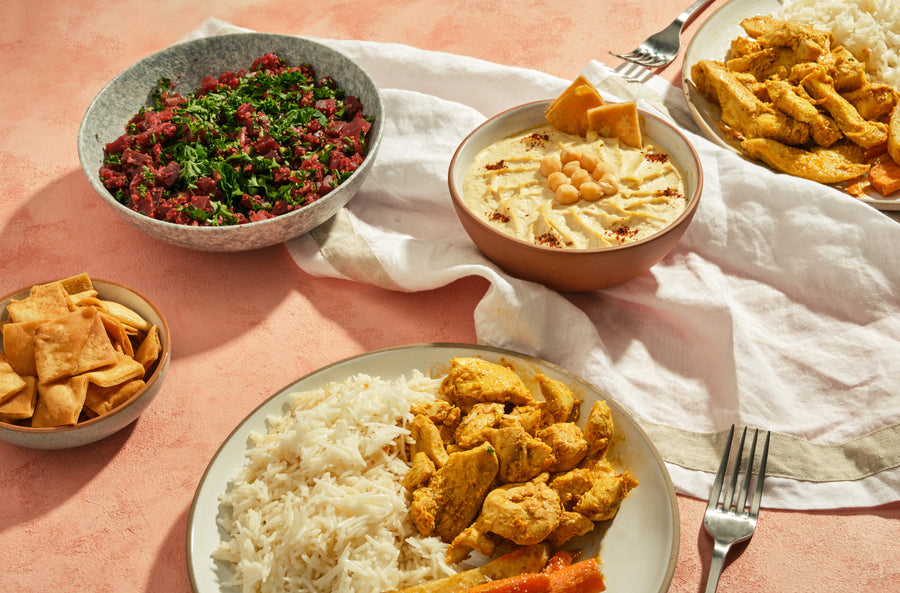A Deep Study Syrian Cuisine: Understanding Its Cultural Relevance and Halal Elements
Syrian cuisine symbolizes a rich tapestry of cultural impacts and historical stories. Each recipe narrates of neighborhood and tradition, highlighting the relevance of common dishes. The adherence to halal techniques not only shows spiritual ideas but additionally forms the identity of Syrian food preparation. As global occasions test these cooking customs, the strength of this cuisine remains a prime focus of social preservation. What exists behind the flavors that define this withstanding heritage?
The Historical Roots of Syrian Food
Although Syrian food has actually evolved over centuries, its historic origins are deeply intertwined with the region's diverse social impacts. Situated at the crossroads of different people, Syria has actually taken in cooking practices from the Phoenicians, Greeks, Romans, and Ottomans, to name a few. This abundant tapestry of history has added to a food characterized by a blend of flavors, seasonings, and cooking strategies. The fertile lands of the region have actually also played a necessary role, supplying an abundance of grains, fruits, and veggies that form the structure of numerous dishes. The introduction of new components through trade and conquest even more enriched the cooking landscape, permitting the development of special local specializeds. In addition, the impact of surrounding nations has actually caused a vibrant exchange of cooking concepts, solidifying Syria's setting as a considerable player in the wider context of Middle Eastern gastronomy.

Traditional Syrian Recipes and Their Cultural Significance
Conventional Syrian dishes are not just culinary staples however likewise bring deep cultural importance, mirroring the nation's rich heritage. Iconic dishes, typically prepared during cheery celebrations, act as a way of uniting neighborhoods and families. These dishes personify the tastes of Syria while reinforcing social bonds via shared traditions and parties.
Iconic Syrian Staples
When discovering the rich tapestry of Syrian food, one uncovers a variety of famous dishes that not only tantalize the palate but likewise symbolize the nation's cultural heritage. Among these staples, Kabsa attracts attention as a fragrant rice recipe, often skilled with flavors like saffron and cardamom, representing hospitality. Fattoush, a vibrant salad made with blended environment-friendlies and crispy bread, shows the value of fresh components in Syrian food preparation. Muhammara, a spicy dip made from walnuts and peppers, showcases the abundant tastes characteristic of the area. Additionally, Kibbeh, a meal made from bulgur and minced meat, is typically considered a nationwide treasure, standing for public events. Each meal tells a tale, connecting people to their practices and origins.
Joyful Meal Practices
Syrian cheery meal traditions are abundant with symbolism and value, as households collect to celebrate important celebrations via the sharing of cherished recipes. Dishes frequently display an array of typical foods, with meals like mansaf, tabbouleh, and kibbeh taking center stage. Each recipe brings social background; for circumstances, kibbeh, made from bulgur and minced meat, represents hospitality and wealth. Throughout Ramadan and Eid, families prepare unique desserts such as maamoul, signifying happiness and unity. These events foster area bonds, as sharing a dish indicates love and togetherness. The prep work and enjoyment of these dishes mirror Syria's diverse cooking heritage, intertwining household custom-mades and regional impacts, thus enhancing the cheery experience and maintaining social identity.
The Duty of Household and Area in Syrian Food Society
Food works as an important thread that weaves together family members and area in Syrian culture. Dishes are usually communal experiences, where households gather around a table to share traditional recipes that reflect their heritage. The prep work of food is a communal task, with generations working side by side, passing down dishes and food preparation techniques. This practice reinforces familial bonds and cultivates a feeling of belonging within the community.Special celebrations and spiritual parties better highlight the significance of food in Syrian society. Throughout these events, family members prepare sophisticated dishes that serve not just to nourish however additionally to reveal love and friendliness. The act of sharing food represents unity and support among friends and next-door neighbors, strengthening social connections. Through these shared culinary experiences, Syrians grow a strong identification rooted in their rich cultural background, illustrating exactly how food transcends plain food to become a crucial part of their social material.
Halal Practices in Syrian Food Preparation
In the context of communal dishes and family members celebrations, halal practices play a considerable function in Syrian cooking. These practices come from Islamic nutritional regulations, making sure that food is ready and eaten in a fashion that aligns with religions. For many Syrian households, adherence to halal concepts affects different elements of dish prep work, from sourcing active ingredients to cooking methods.Animals made use of for meat should be slaughtered according to particular standards, highlighting humane treatment and conjuring up the name of Allah. Furthermore, cross-contamination with non-halal products is carefully prevented in both home cooking areas and industrial establishments.This commitment to halal not just mirrors spiritual commitment however likewise promotes a sense of community, as families often collaborated to share dishes that honor these customs - Brunch Kitsilano Vancouver BC. Halal techniques are deeply woven into the fabric of Syrian cooking society, shaping both day-to-day life and cheery occasions.
Ingredients That Specify Syrian Tastes

The significance of informative post Syrian food is shaped by an unified blend of crucial spices and herbs that improve its distinct flavors. Standard food preparation strategies further boost these components, showcasing the abundant culinary heritage of the region. A review of important components reveals the foundational function they play in producing genuine Syrian meals.
Secret Flavors and Natural Herbs
A vivid tapestry of tastes defines Syrian cuisine, with essential spices and natural herbs playing an important role in specifying its significance. Noticeable among these are sumac, coriander, and cumin, which lend deepness and heat to various recipes. Cumin, with its nutty scent, frequently enhances stews and smoked meats, while coriander adds a citrusy note to dips and salads. Sumac, recognized for its appetizing taste, lightens up meals and is frequently sprayed over fattoush or kebabs. In addition, cinnamon and allspice give a subtle sweet taste, frequently found in both pleasant and tasty preparations. Fresh natural herbs like mint, parsley, and dill are also essential, supplying a burst of freshness and stabilizing the rich, complicated tastes that make Syrian cuisine special.
Conventional Food Preparation Techniques
Food preparation strategies in Syrian cuisine reflect a deep-rooted practice that boosts the tastes of its active ingredients. Approaches such as slow-cooking and braising are frequently employed, enabling flavors and natural herbs to meld beautifully with meats and veggies. Grilling, particularly over charcoal, passes on a smoky richness to dishes like kebabs, while steaming is often used for rice, protecting its structure and taste. In addition, sautéing is favored for preparing aromatic bases, often beginning with onions and garlic to develop deepness. Fermentation contributes in creating special flavors, noticeable in dishes like pickled vegetables. These methods not only highlight the quality of ingredients but likewise embody the communal spirit of food preparation, bringing families together around shared meals steeped in practice.
Crucial Ingredients Overview
While exploring Syrian cuisine, one promptly discovers that vital active ingredients play a critical function in defining its distinct flavors. Olive oil, a staple, provides richness and depth, BBQ Halal Food often acting as a base for many dishes. Fresh natural herbs, such as mint, cilantro, and parsley, contribute dynamic aromas and tastes, boosting the total experience (Brunch Kitsilano Vancouver BC). Flavors like cumin, coriander, and cinnamon are often used, including heat and complexity to meals. Furthermore, Syrian food greatly incorporates grains, specifically bulgur and rice, which function as fundamental elements in different dishes. Pulses, especially chickpeas and lentils, provide both nourishment and structure. Together, these active ingredients create the unified balance that identifies Syrian dishes, showing the country's abundant cooking heritage and cultural value
The Effect of War on Syrian Cooking Traditions
Although the battle in Syria has actually wrought devastation throughout the nation, its effect on culinary practices exposes an intricate interplay of resilience and adjustment. As communities faced displacement, traditional dishes were changed because of the deficiency of resources and components. Families typically depend on in your area offered fruit and vegetables, incorporating brand-new flavors and strategies right into their meals, which brought about the introduction of unique analyses of classic dishes.Moreover, the battle promoted a spirit of uniformity amongst displaced chefs and home chefs, that shared their cooking knowledge through social media and neighborhood kitchens. This sharing of recipes not only managed cultural heritage but likewise developed a feeling of belonging amongst those influenced by the dispute. Despite the difficulties, the passion for food stays a unifying force, permitting individuals to preserve their identity and link with their roots, even in expatriation. As a result, Syrian food remains to evolve amid adversity, reflecting both an abundant background and contemporary resilience.
Often Asked Inquiries
What Prevail Cooking Strategies Utilized in Syrian Cuisine?
Usual food preparation strategies in Syrian food consist of barbecuing, baking, sautéing, and cooking. These techniques enhance appearances and flavors, permitting the development of diverse meals that show the region's rich cooking heritage and practices.
How Has Globalization Influenced Syrian Food?

Exist Vegetarian Options in Conventional Syrian Dishes?
Vegan options prevail in traditional Syrian recipes, featuring components like chickpeas, lentils, and veggies. Popular meals such as Mujadara and Falafel emphasize this diversity, fitting different dietary preferences while protecting the abundant tastes of the cuisine.
What Beverages Set Well With Syrian Dishes?
Drinks that couple well with Syrian dishes consist of mint tea, pomegranate juice, and ayran - Brunch Kitsilano Vancouver BC. These drinks enhance the tastes of typical meals, enhancing the eating experience while offering stimulating contrasts to the rich, tasty tastes
How Do Syrians Commemorate Food During Holidays or Festivals?
Syrians commemorate food during holidays and events with sophisticated banquets, usually featuring conventional dishes. Family gatherings stress sharing meals, representing unity and cultural heritage, while special deals with and sweets highlight the joyful spirit and communal happiness. Traditional Syrian dishes are not only culinary staples however additionally carry deep social importance, reflecting the country's abundant heritage. When checking out the abundant tapestry of Syrian cuisine, one finds a range of famous recipes that not only entice the palate but also personify the nation's cultural heritage. Syrian joyful dish customs are rich with meaning and relevance, as family members gather to commemorate vital occasions through the sharing of cherished meals. Food preparation strategies in Syrian cuisine mirror a deep-rooted custom that improves the tastes of its active ingredients. Vegetarian options are prevalent in traditional Syrian dishes, featuring components like vegetables, chickpeas, and lentils.